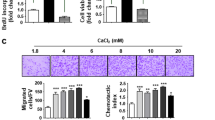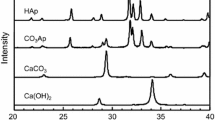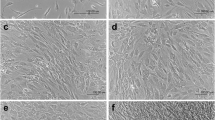Abstract.
The original osteoblastic cell line, MC3T3-E1, was derived from normal mouse bone tissue and mineralized without any specific factors in vitro. This cell line may be slightly unstable because of high differentiation, and some of these cells sometimes lost the ability for mineral deposition. In this study, a new cell line was cloned which lost the ability for mineral deposition from MC3T3-E1 cells. This cell line, termed MC3T3-NM4, was not observed to undergo mineral deposition for up to at least 36 days even in media containing beta-glycerophosphate. The alkaline phosphatase (ALP) activity was also not increased. The lack of calcifying ability was found to be restored by the addition of dexamethasone in the media. This restoration was accompanied by an increase in ALP activity and osteocalcin level. It was suggested that this restoration was not due to artificial mineralization resulting from cell death.
Similar content being viewed by others
Author information
Authors and Affiliations
Additional information
Received: 3 March 1999 / Accepted: 25 May 2000 / Online publication: 22 September 2000
Rights and permissions
About this article
Cite this article
Baba, T. Restoration of Mineral Depositions by Dexamethasone in the Matrix of Nonmineralizing Osteoblastic Cells Subcloned from MC3T3-E1 Cells. Calcif Tissue Int 67, 416–421 (2000). https://doi.org/10.1007/s002230001157
Published:
Issue Date:
DOI: https://doi.org/10.1007/s002230001157




